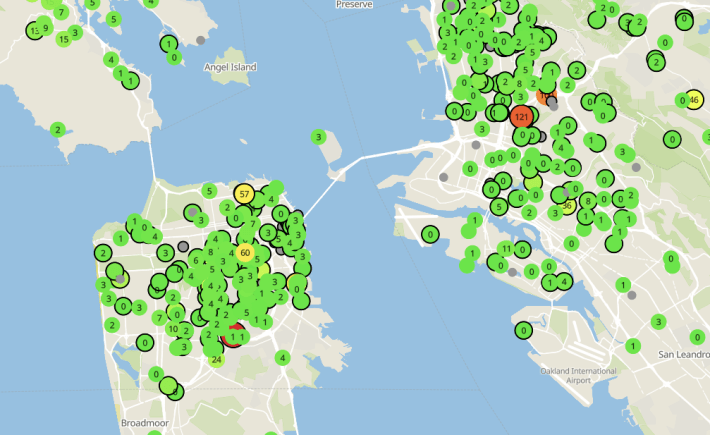Editorial: Traffic Violence and COVID-19 Response
3:57 PM PDT on March 16, 2020

A serious New Year’s Day crash put two in the hospital in the Richmond District
Note: GJEL Accident Attorneys regularly sponsors coverage on Streetsblog San Francisco and Streetsblog California. Unless noted in the story, GJEL Accident Attorneys is not consulted for the content or editorial direction of the sponsored content.
One-point-two-five million people are dying annually in a pandemic. That's about 3,287 deaths a day, with an additional 20-50 million every year injured or disabled (source World Health Organization).
The most recent victim in San Francisco died on Thursday.
Streetsblog is talking not about COVID-19, but about a pandemic that doesn't require any new vaccine to stop it--it's the pandemic of traffic violence.
"Our deepest condolences go out to the family and friends of the 49-year-old man who was hit by the driver of a vehicle when crossing the street at Valencia Street and 18th Street on March 6," wrote Jodie Medeiros, executive director of Walk San Francisco, in a statement released on Thursday about the latest victim. "We have learned that the man has succumbed to his injuries...This is the third person to be hit and killed walking in less than a month.”
That's just in San Francisco. Many more have died in the Bay Area. “With COVID-19, we are all talking about the need to keep everyone in our families and communities as safe as possible, however possible,” added Medeiros. “We should apply this exact same thinking to traffic safety.”
Medeiros is absolutely right. International organizations and national and local governments are spending billions on stimulus packages to mitigate the economic damage. They're also funding research, testing, and medical care and other emergency measures to try and stop the spread of COVID-19. And tonight the Bay Area goes into lockdown.
Despite the death and hardship that the virus is causing, if societies are successful in slowing the spread, COVID-19 could end up saving more lives than it takes.
It's safe to predict that because of quarantines and the concurrent global economic downturn, there will be fewer deaths this year from automobile collisions. And the European Space Agency has released animation mapping the reduction of deadly pollutants, much of it from automobiles, over Italy before and after the quarantine. From an article about the imagery in Space.com:
As people stayed home more and more, nitrogen dioxide emissions in Italy, particularly the country's northern region, fell. [The satellite] Copernicus Sentinel-5P measures levels of this compound, along with ozone, sulfur dioxide, carbon monoxide and methane, among other substances. All of these gases can affect human health and the climate, which is why the ESA monitors them.
And here's a look at Bay Area air quality today, seen here from the site Purple Air. All those green circles indicate the air is unusually pristine, no doubt because so many people who normally drive are now working from home:

To be clear, the exponential growth of COVID-19 infections is the single greatest threat to life that the world is facing at this moment. The Spanish flu of 1918, as a guide, killed 50 million people worldwide in one year. One can only hope COVID-19 will be stopped before it destroys lives at that scale.
But imagine how many more people will die in this epidemic, if every time our authorities decided to take action, they first set up months of outreach meetings and planning and hearings. And yet, that's exactly what happens, even on streets that are already identified as "high-injury corridors," when it comes to fixing dangerous streets.
Valencia is one such street, where a man sustained mortal wounds last week. Although plans are now in motion to "quick build" welcome safety measures, this latest victim might be alive if faster action had been taken. And there are so many other streets where obvious safety measures continue to fester, such as on the Embarcadero, 19th Avenue, pretty much all the streets in the Tenderloin, and others throughout the Bay Area.
Let's legalize and deploy automated speed enforcement cameras, red-light cameras, no-turn on red, and start installing protected bike lanes and intersections on all high-injury corridors without further debate. Let's invest in building out a transit network, so driving cars is no longer necessary to reach so much of the Bay Area. We know how to end traffic violence--Oslo and Helsinki have already achieved Vision Zero and other cities are getting close. We just have to follow their examples.
We don't have to quarantine to stop traffic violence, because we know how to inoculate against it. After COVID-19 is contained, as Medeiros points out, we need to apply the same urgency to traffic safety.
Streetsblog will continue publishing during the COVID-19 lockdown. Obviously, expect our publishing to be lighter than usual and sporadic. Good luck to all of our readers and their loved ones during these difficult times.
Stay in touch
Sign up for our free newsletter
More from Streetsblog San Francisco
Commentary: Making Valencia Better for Business
Curbside protected bike lanes with curbside parklets deliver on much-needed economic benefits for merchants while ensuring safety for all




